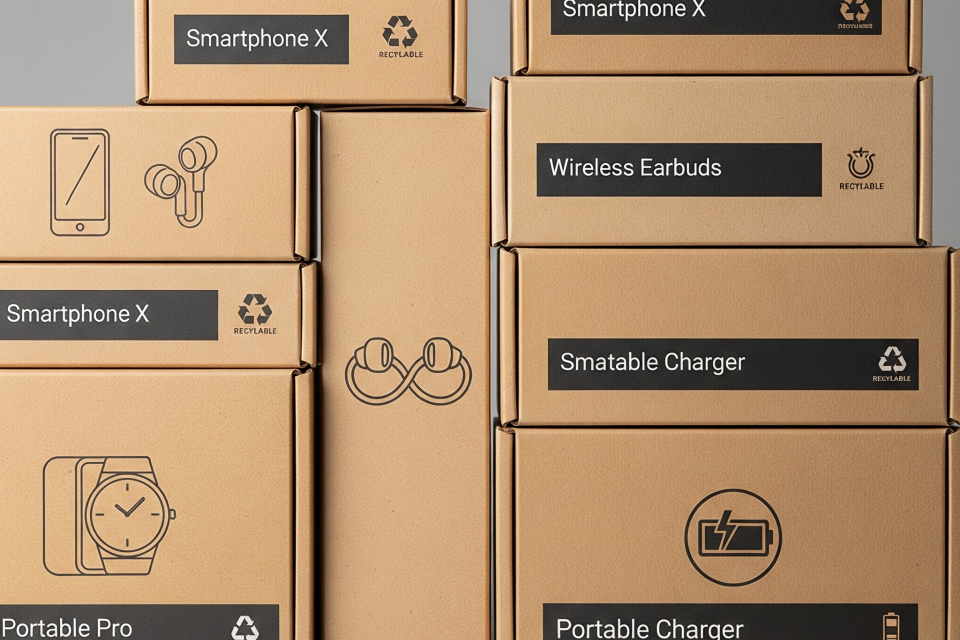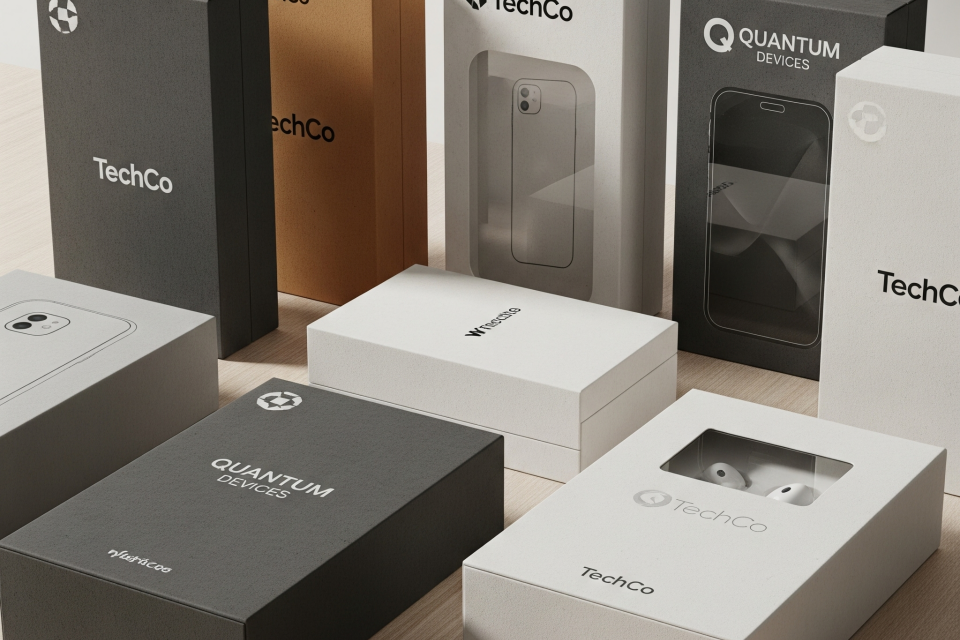Protective Packaging for Electronics
Protective Packaging for Electronics
Summary
Protective Packaging for Electronics is a specialized field dedicated to safeguarding electronic devices during transportation, handling, and storage. As the global electronics market expands, the need for effective packaging solutions has become paramount to ensure that sensitive components, such as smartphones, computers, and industrial machinery, arrive at their destinations intact and functional. This necessity underscores the significance of protective packaging in enhancing product reliability and consumer satisfaction.
The importance of protective packaging is underscored by the diverse materials and designs employed, including foam, plastic, and corrugated cardboard, each providing varying levels of protection against impacts, moisture, and static electricity. For instance, foam packaging offers excellent cushioning through various types, such as polyurethane and anti-static foam, while static shielding bags are specifically engineered to prevent electrostatic discharge that can damage sensitive electronics. Additionally, the industry is witnessing a shift towards sustainable practices, with innovative materials such as biodegradable foams gaining traction as companies aim to align with consumer demand for eco-friendly solutions.
Notably, the field faces several challenges, including the balance between cost and performance, as well as compliance with stringent regulatory standards aimed at ensuring safety and environmental sustainability. Testing protocols established by organizations like the International Safe Transit Association (ISTA) further guide companies in assessing packaging efficacy under real-world conditions. Furthermore, the rise of e-commerce has necessitated the development of specialized packaging solutions tailored to a variety of shipping scenarios, emphasizing the need for adaptability in protective design.
Overall, protective packaging for electronics not only plays a crucial role in preventing damage but also reflects broader trends in sustainability and consumer expectations. The continuous innovation in materials and design strategies highlights the industry's commitment to enhancing the safety and environmental impact of electronic product packaging.

Types of Protective Packaging
Protective packaging encompasses a variety of materials and designs specifically crafted to safeguard electronic components during shipping, handling, and storage. The choice of packaging is crucial to ensure that delicate high-end electronics arrive at their destination without damage, as different types provide varying levels of protection against environmental factors, impacts, and static electricity.
Foam Packaging
Foam packaging is one of the most versatile and effective solutions for protecting electronic devices. It comes in various forms, each offering unique cushioning and shock absorption properties.
Types of Foam
- Polyurethane Foam: Known for its softness and flexibility, polyurethane foam conforms to the shape of items, providing excellent protection against impacts and vibrations. This type is particularly suitable for fragile items like electronics and glassware, though it may absorb moisture, which can be a disadvantage in some contexts.
- Expanded Polystyrene (EPS) Foam: EPS is widely used due to its lightweight nature and excellent shock absorption capabilities. It is often custom-shaped to fit products, making it ideal for protecting delicate electronics and automotive parts from impacts and vibrations.
- Polyethylene Foam: Softer and more flexible than EPS, polyethylene foam offers good cushioning and can be recyclable, making it suitable for delicate parts.
- Anti-static Foam: This type of foam is designed to protect sensitive electronic components from static electricity. It often features a structure that dissipates static charges, preventing electrostatic discharge that can damage electronics.
Custom Foam Inserts
Custom foam inserts are precisely cut to cradle individual products, preventing movement and providing all-around protection. This tailored approach is particularly beneficial for shipping fragile or irregularly shaped items.
Plastic Packaging
Plastic materials provide durable and versatile options for protective packaging.
- Rotomolded Cases: These cases are robust and often used for high-value electronics, providing excellent protection from impacts and environmental elements.
- ATA Flight Cases: Designed for air transport, ATA cases are built to withstand the rigors of travel while ensuring the safety of the electronics inside.
- Moisture Barrier Bags: These bags protect against moisture and are essential for preserving the integrity of metal and electronic components, particularly in humid environments.
Corrugated Cardboard
Corrugated cardboard is frequently used for outer packaging due to its strength, lightweight nature, and cost-effectiveness. It can be combined with foam or other materials to create hybrid packaging solutions that enhance protection for delicate items.
Types of Corrugated Cardboard
- C-flute: A versatile option with good stacking characteristics.
- E-flute: Thinner and ideal for retail packaging due to its excellent printability.
- F-flute: The thinnest option, suitable for small consumer goods packaging.
Static Shielding Bags
Static shielding bags are specifically designed for protecting electronic devices from static discharge. Typically consisting of three layers—dissipative polyethylene, aluminum or carbon for grounding, and a polyester outer layer—these bags are essential for the safe transport and storage of sensitive electronic components.
Environmental Considerations
In recent years, the industry has seen a push towards more sustainable packaging materials. Options such as biodegradable cornstarch foam and seaweed-based packaging are gaining traction, providing effective protection while minimizing environmental impact. Businesses are encouraged to align their packaging choices with broader sustainability objectives by considering the entire lifecycle of the materials used.

Design Considerations
When designing protective packaging for electronics, several critical factors must be addressed to ensure the safety, reliability, and performance of the packaged products. The following sections outline the primary considerations that packaging designers need to evaluate.
Thermal Management
Effective thermal management is vital in electronic packaging design, as excessive heat can damage electronic components or reduce their lifespan. Packaging must facilitate adequate heat dissipation, using materials with high thermal conductivity, such as aluminum nitride, or incorporating heat sinks into the design. Careful design considerations for printed circuit board (PCB) layouts, along with simulation and testing, help ensure that electronic devices remain within safe operating temperatures.
Mechanical Protection
One of the foremost considerations in packaging design is mechanical protection, which entails creating packaging that can withstand physical shocks, vibrations, and other environmental stresses during transportation and storage. This includes using materials that can absorb impacts, resist punctures, and maintain integrity under pressure. Testing methods such as shock testing and vibration testing are essential to assess how well the packaging can handle these challenges without compromising the contents.
Material Selection
The choice of materials plays a crucial role in the performance and sustainability of protective packaging. Designers should select durable materials capable of withstanding shipping and storage rigors while also addressing sustainability goals. The use of recycled and bio-based resins is encouraged, as these materials can provide excellent protection while minimizing environmental impact. Moreover, incorporating identifiable resin codes and designing for recyclability during the packaging process contributes to a more sustainable lifecycle for electronic products.
Non-Toxic and Non-Flammable
The choice of materials is crucial, particularly in electronic packaging where user safety is a priority. Materials selected should be non-toxic and non-flammable to minimize safety hazards. Additionally, environmental considerations play an essential role, as sustainable packaging solutions are increasingly demanded by consumers. Materials sourced from responsibly managed forests contribute to a circular economy, enhancing brand image while meeting sustainability expectations.
Performance and Reliability
Materials must meet specific electrical, thermal, and mechanical performance specifications. This includes assessing their ability to withstand environmental stresses, such as temperature fluctuations and humidity. Reliability testing ensures that the packaging maintains its performance over time, safeguarding the electronic components inside.
Environmental Considerations
Packaging must be designed to protect electronics from environmental factors such as humidity, temperature fluctuations, and exposure to light. Effective moisture control is essential to prevent corrosion and physical damage, and can be achieved through the use of moisture-absorbing materials like desiccants or vacuum-sealed packaging. Additionally, humidity and altitude testing should be performed to ensure that packaging can endure varying conditions encountered during transport and storage.
Design for Manufacturability and Assembly
Designing for manufacturability (DFM) and assembly is another key principle in packaging design. This involves simplifying designs to reduce complexity, standardizing components, and creating packaging that can be easily assembled. Such considerations help minimize production costs and improve efficiency while ensuring that the final packaging meets the required specifications for protection and functionality.

Key Selection Criteria
When selecting protective packaging for electronics, several key criteria must be considered to ensure the integrity, safety, and performance of the products during transit and storage.
Protective Features
Environmental Protection
Packaging should provide environmental-proofing against moisture, mold, and extreme temperatures. For instance, anti-static materials are essential for protecting sensitive electronics from electrostatic discharge (ESD), which can damage components during storage and transit. Moreover, utilizing materials that offer resistance to environmental stresses ensures the longevity and reliability of the product.
Physical Damage Prevention
Effective packaging design should create barriers that safeguard against physical damage from impacts, vibrations, and shocks. This involves using cushioning materials to absorb forces and minimize movement during transportation. Tests such as weathering, corrosion, and tensile strength assessments are critical in determining how well packaging materials will perform under various conditions.
Cost and Manufacturability
The cost of materials and their impact on the overall product price must be evaluated. Additionally, manufacturability refers to the ease with which materials can be processed and assembled into the final product. This consideration ensures that the selected packaging solutions are not only protective but also economically viable and practical for production.
Quality Control Measures
Incorporating quality control measures, such as visual and dimensional inspections, is critical to ensuring that the packaging meets required specifications before it is used for shipping electronics. Functional testing can also confirm that the packaging provides the necessary protection for the devices it contains.
By carefully evaluating these selection criteria, companies can develop effective protective packaging that not only enhances product safety but also boosts customer satisfaction and brand loyalty.
Industry Standards and Regulations
The protective packaging for electronics is subject to a variety of industry standards and regulations designed to ensure safety, reliability, and environmental sustainability. These regulations are essential for companies to maintain compliance while also addressing consumer demand for eco-friendly solutions.
Government Regulations
Governments worldwide implement regulations that significantly influence the packaging industry. For instance, regulations that limit the use of materials like polyethylene terephthalate (PET) promote the adoption of sustainable alternatives, ultimately aiding in pollution reduction and climate change mitigation. In the European Union, stringent regulations such as the Medical Device Regulation (MDR) enforce compliance with safety standards before products can be marketed, ensuring that packaging meets necessary requirements for hazardous materials.
International Standards
The International Organization for Standardization (ISO) plays a crucial role in setting worldwide standards relevant to packaging. Key ISO standards include ISO 11607, which specifies requirements for packaging systems used for terminally sterilized medical devices, and ISO 8317, focusing on child-resistant packaging to prevent children's access to harmful substances. Additionally, the International Safe Transit Association (ISTA) provides test protocols that simulate real-world conditions during transportation, assessing a package's endurance against vibration, shock, temperature, and humidity variations.
Industry Guidelines and Certifications
Industry guidelines and certifications are pivotal for promoting sustainable packaging solutions. These standards encourage the use of recyclable materials, such as cardboard and seaweed-based packaging, and aid in enhancing brand reputation by assuring consumers of the environmental responsibility of their products. Compliance with these guidelines not only helps companies avoid potential fines but also positions them favorably for sustainable finance opportunities.
Packaging Testing Standards
Testing is essential for ensuring that packaging complies with relevant regulations. Various testing methods, such as electrical performance tests and interfacial integrity tests, are employed to assess the reliability of packaging structures under different environmental conditions. Companies must decide whether to conduct testing in-house or outsource it, balancing control and cost against access to expert facilities.
E-commerce and Specialized Packaging
E-commerce has introduced unique packaging requirements due to the diverse range of products shipped directly to consumers. ISTA offers standardized test procedures to evaluate the protective capabilities of e-commerce packages during distribution. Furthermore, specific packaging standards govern hazardous materials to ensure safe transportation, with regulations differing by region—such as TP14850 in Canada and 49 CFR Parts 171-180 in the United States.
Innovations in Protective Packaging
Innovations in protective packaging are continually evolving to meet the needs of various industries, particularly in electronics, where safeguarding delicate components is critical. This section explores recent advancements in materials and technology that enhance the effectiveness and sustainability of protective packaging solutions.
Advanced Materials
Eco-Friendly Options
The shift towards sustainable materials is a significant trend in the packaging industry. Companies are increasingly utilizing biodegradable and compostable materials, such as bio-based plastics and molded pulp, to create protective packaging that minimizes environmental impact. Innovations include materials derived from renewable resources like bamboo and cornstarch, which not only provide effective protection but also appeal to environmentally conscious consumers. For instance, Dell Technologies has adopted mushroom-based packaging that decomposes naturally, showcasing a commitment to eco-friendly practices.
Intelligent Packaging
Smart packaging technology is another groundbreaking development, integrating sensors and tracking systems into packaging solutions. These advancements enable real-time monitoring of conditions such as temperature and humidity, ensuring product integrity throughout the supply chain. Features like QR codes and radio-frequency identification (RFID) facilitate product authentication and inventory tracking, enhancing overall efficiency and customer satisfaction.
Customization and Design
Tailored Solutions
The customization of protective packaging is becoming increasingly important. Businesses can create bespoke solutions using thermoformed plastics and foam inserts to ensure a secure fit for various electronic devices. This not only enhances protection during transit but also improves the presentation of the products, contributing to a positive first impression for consumers.
3D Printing and Data Analytics
The use of 3D printing and data analytics in packaging design allows for rapid prototyping and adjustments based on market demands, promoting both efficiency and sustainability. These technologies enable companies to optimize material usage, reducing waste while still providing robust protection for their products.
Sustainability Initiatives
Balancing Protection and Environmental Responsibility
As industries face increasing pressure to adopt sustainable practices, protective packaging solutions are evolving to balance functionality with environmental responsibility. Businesses are exploring the use of recycled materials and right-sizing packaging to reduce excess waste. Sustainable protective packaging not only meets regulatory requirements but also resonates with consumers who prioritize brands committed to reducing their carbon footprint.
Case Studies
A/B Testing in Packaging Design
A/B testing has become a valuable method for evaluating packaging design within the electronics industry. By comparing two versions of a packaging design, companies can assess which one resonates more effectively with users based on preferences and market responses. This method is particularly useful for identifying design elements that enhance user interaction, such as ease of handling and clarity of information. For example, tech companies may test variations in box design to determine which configuration results in higher customer satisfaction and reduced returns.
Ergonomic Considerations
Ergonomic testing plays a crucial role in the development of electronics packaging. This approach evaluates how comfortably and efficiently users can interact with packaging, focusing on aspects like the ease of lifting, holding, and opening the package. For instance, ergonomic design is especially important in industrial settings, where workers frequently handle packaging. Companies are increasingly adopting ergonomic principles to minimize user strain and enhance comfort, thereby improving the overall user experience with electronic products.
Sustainability in Electronics Packaging
As consumer demand for eco-friendly solutions grows, electronics companies are increasingly exploring sustainable packaging materials. For instance, Dell Computer has pioneered the use of "eco-friendly cushioning" in their packaging designs, which highlights the shift towards sustainability in electronics packaging. This move not only addresses environmental concerns but also appeals to a market segment that prioritizes sustainable practices.
Conductive Packaging for ESD Protection
Electrostatic discharge (ESD) is a significant concern in the electronics industry, potentially causing damage to sensitive components. To mitigate this risk, manufacturers are employing various conductive packaging materials specifically designed for ESD protection. These materials are essential for ensuring the reliability and functionality of electronic devices, illustrating the critical role of protective packaging in the manufacturing process. Companies are continually innovating to improve the properties of these materials, enhancing their effectiveness against ESD threats.
Innovative Design Examples
The evolving landscape of electronics packaging is marked by innovative designs that prioritize both protection and aesthetics. Companies are investing in high-quality packaging that not only safeguards products but also enhances brand identity and consumer appeal. For example, premium materials and unique structural designs can create a memorable unboxing experience, which is increasingly recognized as a vital aspect of product marketing.
Through these case studies, it is evident that protective packaging for electronics is not only about safeguarding products but also encompasses user experience, sustainability, and marketing strategies. The industry's focus on innovation and responsiveness to consumer needs continues to shape the future of electronics packaging.
